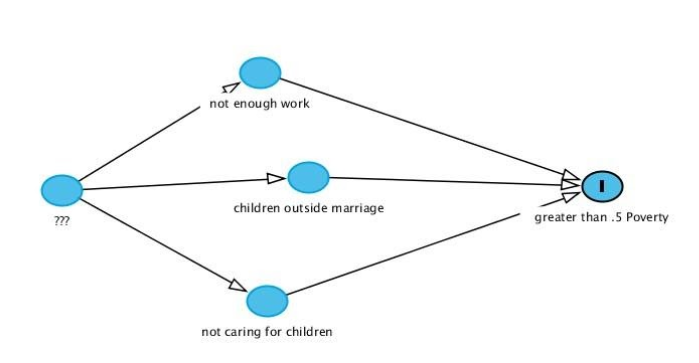Culture and Poverty
Author: Michael Lewis, Professor
Silberman School of Social Work, Hunter College
Lawrence Mead is a political scientist who is on the faculty at New York University. For years, he has been writing about poverty, as well as policies ostensibly intended to address it. He is perhaps best known for his work supporting workfare, the practice of requiring recipients of certain types of cash benefits to work, or engage in some work-related activity, in return for those benefits. Recipients who fail to do so, risk having those benefits terminated.
Not only has Mead argued that we should make welfare recipients work in return for their benefits, but he’s also looked into the broader question of why people end up poor. His answer is that even though there is plenty of opportunities to work, the main reason folks end up poor is that they don’t work enough. And they don’t work enough because of a defeatist attitude. Mead’s latest look into the question of what causes poverty is a variation on his non-work theme. Mead now claims that cultural differences between the West and non-West are primarily what explain poverty (Mead, 2020).
It would be putting it mildly to say that Mead’s most recent version of his theory of poverty is controversial. In fact, some have called it outright racist. Although I have my views about that charge, for the purposes of this post, I’m going to put those aside. Instead, I’ll take a somewhat different approach.
Mead’s essay appears in a journal called Society, which claims to publish work across the social sciences. So, I suppose it’s fair to evaluate Mead’s contribution as a work in social science. Given the type of argument he makes, it’s best understood as a work in theoretical social science, in the sense that he’s trying to explain a social phenomenon. Viewed this way, how good is Mead’s argument? Let’s take a look.
Readers familiar with the logic or critical thinking literature will recognize that Mead’s argument is an example of a type called inference to the best explanation. These arguments have the following form:
- Some facts to be explained
- Some explanation of that fact, which is considered the best explanation of it
- The conclusion that this best explanation is most likely to be the true one
In Mead’s case, what is the fact to be explained? It’s that most poverty arises from adults not working enough, having children outside of marriage, and not taking care of those children. Let’s dig into this a bit.
Mead is attempting to explain an outcome, as well as several different causes. The outcome is the existence of more than half of the poverty in the U.S.; the causes are 1) adults not working enough 2) adults having children outside of marriage 3) adults not taking care of those children. We can use the following diagram to see this more clearly:

The oval labeled greater than .5 poverty represents the outcome. Mead claims that this is immediately caused by the factors represented by the middle three ovals: folks not working enough, having kids outside of marriage, and not taking care of those kids. The oval labeled ??? is where Mead wants to make his contribution. That is, his inference to the best explanation argument is focused there: he wants to tell us why people (particularly, as you’ll see, Black and Latinx people) don’t work enough, have kids out of wedlock, and often don’t take care of their children. This explanation, as he sees it, will tell us what ultimately causes most of the poverty in the U.S.
In order to fill in these three question marks, Mead claims that there are two different cultures that we need to consider: Western and non-Western. Western (read European) culture is individualist and views life as a project; this renders Westerners more ambitious. Non-Western (read Black and Latinx) culture is collectivist, with most Black and Latinx folks having, “little sense that they are separate from society.” Non-Westerners’ chief goal is survival, instead of advancement.
Another cultural difference between the West and non-West has to do with ethics. Westerners understand ethical standards as universal principles of right and wrong. Non-Westerners view such standards as contextual; that is, most of them understand right and wrong on the basis of what behavior others expect of them. For the moment, this is enough of an overview of Mead’s perspective. Let’s begin evaluating it.
I said above that Mead is trying to explain where ultimately most poverty in the U.S. comes from. Most means more than half. So, Mead is trying to explain where more than half of the poverty in the U.S. comes from. He’s claiming that adults not working enough, having children outside of marriage, and not taking care of those children directly explain more than half of the poverty we observe. Cultural differences between Blacks/Latinx folks and Whites indirectly explain more than half of it, by explaining why there’s so little work, so few two-parent families, and so little care for their children among Black and Latinx people. Mead makes these claims as if they’re part of a social scientific consensus; they aren’t.
First, the claim that Black and Latinx people don’t care for many of their children is highly contentious. Mead offers no evidence to support this assertion, so it’s hard to know what he’s basing it on. Perhaps he’s assuming that noncustodial fathers aren’t taking care of their children. If so, his reasoning is flawed; parents don’t have to live with their children in order to take care of them.
There is evidence that the more one works, the less likely they are to be poor. This can be seen by taking a look at Table 3 of this document; you’ll see that in 2017, those who worked full-time, year-round had a poverty rate of around 2%, while those who didn’t work full-time, year-round had one of about 13%. Also, single-parent families, where that parent is female, do appear to have a higher poverty rate than do two-parent families (see here). However, neither of these findings imply that most poverty stems from people not working enough, female-headedness, and folks neglecting to care for their children.
In order for Mead’s argument to go anywhere, the following would have to be the case. First, there would need to be some measure of the total amount of poverty in the U.S. Second, there would need to be some decomposition of that total amount, showing that more than half of it stems from the factors represented by the three middle ovals in the diagram above: not enough work, children outside marriage, not caring for children.
Think of a whole pie representing the total amount of poverty in the U.S. Imagine that the pie is cut into a number of slices, where three of those slices represent not enough work, children outside marriage, and not caring for children. In order for Mead’s argument to get anywhere, those three slices would have to make up more than half of the pie. The problem for Mead is that he doesn’t provide us with such a decomposition of poverty in the U.S. I suspect that the reason he doesn’t is that no such decomposition exists; at least, I know of no such decomposition.
So, it appears that Mead is attempting to explain a link between certain proximate causes and an outcome without having shown that such a link exists. If you can’t show that the thing you’re trying to explain exists, that doesn’t bode well for your attempted explanation of it. So, invoking the principle of charity, let’s see if we can make Mead’s argument stronger.
Mead’s main point is that Blacks and Latinx folks in the U.S. come from non-Western cultures, while White folks come from Western culture. According to available data, the poverty rates for Blacks and Latinx people are both higher than that for Whites. Let’s assume that this is the finding that Mead is ultimately trying to explain. It’s also the case that the proportion of single White women with children under 18 is lower than those for Black and Latinx women (see table A3 here) and that the unemployment rates for Blacks and Latinx persons are higher than that for Whites.
So, let’s recast Mead’s argument a bit differently. Remember I’m trying to help him out, but it’s possible that I’m mischaracterizing his position. If so, he or others should feel free to correct me. The link he’s trying to explain is that between the higher female-headed family and unemployment rates among Blacks and Latinx folks, compared to Whites (proximate cause), and the higher rates of poverty among Blacks and Latinx folks, compared to Whites (the outcome). The cultural differences between Blacks/Latinx folks and White ones (ultimate cause of the outcome) explain why Blacks/Latinx folks have higher female-headedness and unemployment rates, and this explains why they have higher poverty rates. The problem with this version of the argument is that Mead provides little evidence that such cultural differences exist.
The only evidence Mead offers in support of his claim about cultural differences are references to the works of three authors: Geert Hofstede (1980), Richard E. Nisbett (2003), and Ingelhart and Welzel (2005). Hofstede claims to have found international differences in work cultures, across four different dimensions, one of which is individualism/collectivism. Some doubt that what Hofstede found were actually cultural differences (Baskerville, 2003). But, for the sake of argument, let’s assume that he did find such differences.
The book Mead refers to is based on survey work Hofstede did in the late 1960s/early 1970s. Why should we believe that these findings have anything to do with what’s going on with the family structures and unemployment rates among Blacks, Latinx, and White folks today? Don’t get me wrong—these findings could be relevant today. But that is something that would have to be demonstrated; Mead does no such thing.
Nisbett’s book is about alleged cultural differences between Asians and Westerners. Assuming, just for the sake of argument, that he did observe such differences, what on earth would they have to do with the racial differences among Blacks, Whites, and Latinx folks that Mead is trying to explain?
I can make a similar point about Ingelhart and Welzel’s book. It appears to be about how cultural changes across the world are leading to an expansion of modern democracy. Mead fails to tell us what this has to do with racial differences in unemployment and family structure in the U.S. So, even if we are charitable to Mead, the evidence he offers in support of his cultural differences claim appears irrelevant to it.
Although not a major part of Mead’s essay, I feel compelled to address one section that is especially troubling. At one point, he claims that during slavery and the Old Jim Crow era, crime and female-headedness among Blacks weren’t much higher than they were among Whites. Once these systems were lifted, there were increases, among Blacks, in both crime and the rate of families headed by women.
Black people were kidnapped from Africa, dragged across the Atlantic, sold into a system, which required them to work sun up to sun down for years on end, and faced the risk of being maimed or killed if they resisted. I suspect that crime among blacks was pretty low back then. People living in chains, both figuratively and literally, as slaves were, don’t have much opportunity to commit crimes. During the Old Jim Crow era, Blacks were no longer enslaved, but they were still subjected to a system of racial oppression, surveillance, debt peonage, and violence which had many of the same features as slavery.
If I drag some people from their homes, force them to work for me, under constant surveillance, beat, maim, or kill them if they resist, and chain them to their beds while they sleep, they’re not going to get much chance to commit crimes. I wonder how many people would claim, along with Mead, that this would be good for social order. People trafficked into sex slavery probably don’t commit many street crimes. If so, is sex slavery good for social order?
The suggestion that slavery was somehow good for Black families is equally astounding. Enslaved Blacks couldn’t legally marry, although many slaves formed unions which they regarded as marriages. Owners often disagreed with these slaves’ assessment, indicating such disagreement by selling spouses and children away, with no regard for these so-called marriages. Mead still claims that female-headedness was lower during slavery and the Old Jim Crow system than after those systems ended. There is evidence that supports his claim. The problem for Mead’s argument, though, is that it doesn’t just apply to Blacks.
Since 1960, the proportion of two-parent families has been declining for all races, at least all those I could find data for. It’s true that the proportion of two-parent families is lower among Blacks and Latinx folks. But since it’s declined across the board, does that mean that the U.S. culture has become less Western? Then there is the peculiar finding, from the point of view of Mead’s argument, about Asians and whites; in 2015, 19% of white families lived in single-parent households headed by women, while 13% of Asian families did. At one point in his essay, Mead tells us that Asian culture is non-Western. If marriage rates are indicative of differences between Western and non-Western cultures, with marriage being more likely among Westerners, Whites are Westerners, and Asians are non-Westerners, why don’t Whites have a higher proportion of two-parent families than do Asians?
Mead’s mention of slavery raises other questions about his argument. Even if we grant his Western versus non-Western culture dichotomy, Blacks have been in the U.S. for over 400 years. Why is a group of people who’ve been in this country for over four centuries, during which, for much of that time, slavers deliberately tried to stamp out their culture, still viewed as having a foreign culture? The minute we ask this question, others arise.
Many Latinx folks are descended from Spanish people. Spain is in Europe; so, presumably, it’s part of Western Culture. Why are Latinx (Mead prefers the term Hispanic) people, those descended from Spain at least, viewed as non-Western? Shouldn’t they have at least a little Western in them?
And let’s go back to Asians. Not only, as mentioned previously, do they have a higher rate of two-parent families than Whites, but they also have lower or about the same levels of unemployment as Whites, depending on when you look. But, again, Mead himself says they’re non-Western. If high unemployment is indicative of non-Western culture, shouldn’t Asians’ unemployment rate be higher than that of White folks?
I said earlier that the journal which published Mead’s piece claims to feature works in the social sciences. If the folks who reviewed his essay believe that it meets scientific standards, I think they should reconsider their views about what constitutes science.
Since this is a basic income blog, I should close by saying a bit about how all of this is related to that policy proposal. Basic income proponents are a diverse bunch; that is, we have put forth a variety of reasons to justify the policy. One thing we all have in common, though, is this: we’re advocating a policy which severs, to some degree, the tie between income and work, with work defined as the sale of labor power in return for a wage or salary. This comes right up against the so-called work ethic, the idea that people should work for their incomes, instead of having it handed to them for nothing.
Mead, for many years now, has been an uncompromising proponent of the work ethic. He certainly has a bully pulpit that many others don’t have. But he obviously isn’t the only person who holds these views. I’ve been writing about basic income, off and on, for over 20 years. I’ve watched as it’s gone from being viewed as a strange idea with a few, even stranger, proponents, to, arguably, becoming part of mainstream policy discourse. So, things may be looking better than ever for basic income proponents; Mead’s ideas are a powerful reminder of what basic income supporters, even now, are up against.
*Editor’s note: Since this blog post was written, the editor of Society has recommended that the journal retract the publication of Mead’s article.



Leave a Reply
Want to join the discussion?Feel free to contribute!